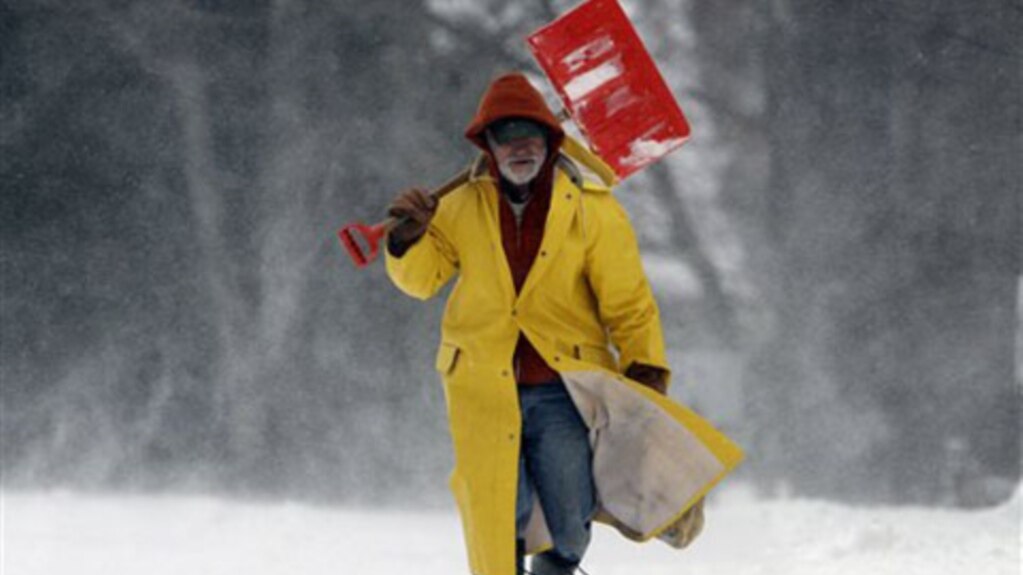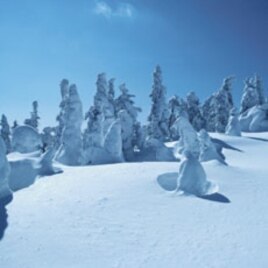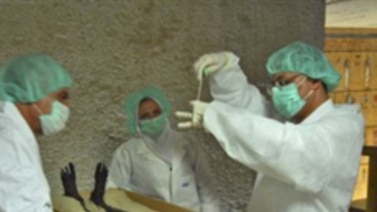
FAITH LAPIDUS: This is SCIENCE IN THE NEWS, in VOA Special English. I’m Faith Lapidus.
BOB DOUGHTY: And I’m Bob Doughty. Today, we will tell you everything you wanted to know about snow.
(MUSIC)
FAITH LAPIDUS: Winter has returned to northern parts of the world. In the northern United States, winter can mean the return of snow. Large amounts of snow fell in some American cities last month. One storm hit the East Coast, causing flight cancellations and temporarily stopping traffic in some areas.
Snow is a subject of great interest to weather experts. They sometimes have difficulty estimating where, when or how much snow will fall. One reason is that heavy amounts of snow fall in surprisingly small areas. Another reason is that a small change in temperature can mean the difference between snow and rain.
BOB DOUGHTY: Just what is snow, anyway? Snow is a form of frozen water. It contains groups of ice particles called snow crystals. These crystals grow from water droplets in cold clouds. They usually grow around dust particles.
All snow crystals have six sides, but they grow in different shapes. The shape depends mainly on the temperature and water levels in the air.
Snow crystals grow in one of two designs – plate-like and columnar. Plate-like crystals are flat. They form when the air temperature is about fifteen degrees below zero Celsius. Columnar snow crystals look like sticks of ice. They form when the temperature is about five degrees below zero.
FAITH LAPIDUS: The shape of a snow crystal may change from one form to another as the crystal passes through levels of air with different temperatures. When melting snow-crystals or raindrops fall through very cold air, they freeze to form small particles of ice, called sleet. Groups of frozen water-droplets are called snow pellets. Under some conditions, these particles may grow larger and form solid pieces of ice, or hail. Hail can be dangerous to people, animals and property.
(MUSIC)
BOB DOUGHTY: When snow crystals stick together, they produce snowflakes. Snowflakes come in different sizes. As many as one hundred crystals may join to form a snowflake larger than two and one-half centimeters. Under some conditions, snowflakes can form that are five centimeters long. Usually, this requires near-freezing temperatures, light winds and changing conditions in Earth’s atmosphere.
Snow contains much less water than rain. About two and one-half centimeters of rain has as much water as fifteen centimeters of wet snow. About seventy-six centimeters of dry snow equals the water in two and one-half centimeters of rain.
FAITH LAPIDUS: Much of the water the world uses comes from snow. Melting snow provides water for rivers, electric power stations and agricultural crops. Mountain snow provides up to seventy-five percent of all surface water supplies in the western United States.

Snowfall helps to protect plants and some wild animals from winter weather. Fresh snow is made largely of air trapped among the snow crystals. Because the air has trouble moving, the movement of heat is limited.
Snow also influences the movement of sound waves. When there is fresh snow on the ground, the surface of the snow takes in, or absorbs, sound waves. However, snow can become hard and flat as it grows older or if there have been strong winds. Then, the snow’s surface will help to send back sound waves. Under these conditions, sounds may seem clearer and may travel farther.
BOB DOUGHTY: Generally, snow and ice appear white. This is because the light we see from the sun is white. Most natural materials take in some sunlight. This gives them their color. However, when light travels from air to snow, some light is sent back, or reflected. Snow crystals have many surfaces to reflect sunlight. Yet the snow does take in a little sunlight. It is thislight that gives snow its white appearance.
Sometimes, snow or ice may appear to be blue. The blue light is the product of a long path through the snow or ice. Think of snow or ice as a filter. A filter is designed to reject some substances, while permitting others to pass through. In the case of snow, light makes it through if the snow is only a centimeter thick. If it is a meter or more thick, however, blue light often can be seen.
(MUSIC)
FAITH LAPIDUS: Snow falls in the Earth’s extreme North and South throughout the year. However, the heaviest snowfalls have been reported in the mountains of other areas during winter. These areas include the Alps in Italy and Switzerland, the coastal mountains of western Canada, and the Sierra Nevada and Rocky Mountains in the United States. Snow is even known to fall near the Equator, but only on the highest mountains.
BOB DOUGHTY: Sometimes, snow comes earlier than normal. And sometimes it falls in areas that are not known for having snow. In early December, ice and heavy snow caused officials in Paris to close its main airport and the Eiffel Tower. It was the heaviest snowfall in the French capital has received in years.
Snow also fell in other parts of Europe. Scotland received its heaviest snowfall since nineteen sixty-three. A combination of snow, rain and freezing conditions caused traffic problems in Germany. There were hundreds of accidents nationwide. Hundreds of flights were cancelled, most of them at the Frankfurt airport.
FAITH LAPIDUS: Each year, the continental United States has an average of one hundred five snowstorms. An average storm produces snow for two to five days.
Almost every part of the United States has received snowfall at one time or another. Even parts of southern Florida, where many Americans go for warm-weather vacations, have reported a few snowflakes.
The national record for snowfall in a single season was set in the winter of nineteen ninety-eight to nineteen ninety-nine. Two thousand eight hundred ninety-five centimeters of snow fell at the Mount Baker Ski area in the northwestern state of Washington.
BOB DOUGHTY: People in many areas have little or no snowfall. In 1936, a physicist from Japan produced the first man-made snow in a laboratory. Then, during the 1940s, several American scientists developed methods for making snow in other areas. Clouds with extremely cool water are mixed with man-made ice crystals, such as silver iodide and metaldehyde crystals. Sometimes, dry ice particles or liquid propane are used. Today, machines are used to produce limited amounts of snow for winter ski areas when not enough natural snow has fallen.
(MUSIC)
FAITH LAPIDUS: Snow may be beautiful, but it can be deadly. It is responsible for the deaths of hundreds of people in the United States every year. Many people die in traffic accidents on roads that are covered with snow or ice. Others die from being out in the cold, or from heart attacks caused by too much physical activity.
You may not be able to avoid living in areas where it snows often. However, you can avoid becoming a victim of snowstorms. Most people are told to stay in their homes until the storm has passed. When removing large amounts of snow, they should stop and rest often. Difficult physical activity during snow removal can cause a heart attack, especially among the elderly.
It is always a good idea to keep a lot of supplies in the home, even before winter begins. These supplies include food, medicine, clean water and extra power supplies.
BOB DOUGHTY: Drivers have become trapped in their vehicles during a snowstorm. If this happens, people should remain in or near their car unless they see some kind of help. They should get out and clear space around the vehicle’s exhaust pipe to prevent the possibility of carbon monoxide poisoning.
Drivers should tie a bright-colored object to the top of their car to increase the chance of rescue. Inside the car, they should open a window a little for fresh air and turn on the engine for ten or fifteen minutes every hour for heat.
People living in areas where winter storms are likely should carry emergency supplies in their vehicle. These include food, emergency medical supplies and extra clothing to stay warm and dry. People in these areas should always be prepared for winter emergencies.
(MUSIC)
FAITH LAPIDUS: This SCIENCE IN THE NEWS was written by Christopher Cruise. June Simms was our producer. I’m Faith Lapidus.
BOB DOUGHTY: And I’m Bob Doughty. Read and listen to our programs at voaspecialenglish.com. Join us again next week for more news about science in Special English on the Voice of America.




